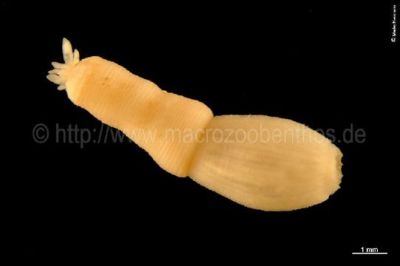Photo by BOLD, Biodiversity Institute of Ontario, Creative Commons Attribution Non-Commercial Share Alike
| Priapulida | ||
| Scalidophora | Priapulida |
| Loricifera | Ecdysozoa | Scalidophora
└─► |
||
| Ecdysozoa | None |
Nematoida |
|
Abbreviated Dendrogram
Bilateria
├─Deuterostomia
└─┬─Spiralia
│
└─Ecdysozoa = paraphyletic Scalidophora?
├─Markuelia
├─Kinorhyncha
╞═Palaeoscolecida
╞═Priapozoa
│ └─┬─Priapulida
│ └─┬─Sirilorica
│ └─Loricifera
└─┬─Nematoida
└─Panarthropoda
|
Contents
Overview |
Photo by BOLD, Biodiversity Institute of Ontario, Creative Commons Attribution Non-Commercial Share Alike |
There are fewer than 20 described living species of Priapula (or Priapulida), although additional species are known that await formal description. Priapulans are free-living benthic marine worms with an eversible proboscis. They range in size from 1 mm (early instars may be as small as 50 µm) to more than 40 cm in length . They can be found from polar seas to the tropics and from ocean trenches to the intertidal zone. Some species can occur in extremely high densities. Sexes are separate and in at least one family sexual dimorphism is evident. Males spawn first, then females; fertilization is external. Nearly all species have a non-swimming benthic larval stage, which apparently may last as long as one to two years. Larvae live in mud and are probably detritivores. The body of a priapulan is cylindrical and includes an introvert (retractable and invertible proboscis), a neck-like collar, a trunk, and sometimes a "tail". The introvert has spines resembling those on the introvert of kinorhynchs and loriciferans. Large priapulans burrow actively in relatively fine marine sediments, primarly in boreal and cold temperate seas. A few species construct tubes. Small priapulans burrow or live interstitially among sediment particles. Priapulans are relatively common in the fossil record and may have been important predators in Cambrian seas. Most priapulans today live in soft sediments and feed on soft-bodied invertebrates such as polychaete worms and other priapulans. During feeding, a portion of the toothed pharynx is everted through the mouth at the end of the extended introvert, then retracted together with the prey item. (Brusca and Brusca 2003; Shirley 2009 and references therein; Margulis and Chapman 2010).
The Priapula are believed to be closely related to the Kinorhyncha and Loricifera, with which they are often grouped in a clade referred to as Scalidophora; some authors include the Nematomorpha as well in a clade referred to as Cephalorhyncha (Aleshin et al. 1998 and references therein; Halanych 2004 and references therein). Sørensen et al. (2008) present data that they argue supports a sister relationship for Loricifera and Nematomorpha, which would render the Scalidophora paraphyletic. As of 2010, relationships among phyla within the Ecdysozoa remain poorly resolved, so it is difficult to know which groups will eventually win wide acceptance by specialists as convincingly monophyletic.- text © Leo Shapiro (Creative Commons Attribution Non-Commercial Share Alike)

Priapulida: Ottoia, Palaeoscolex, Priapulus etc
fr the Carboniferous
Phylogeny: Priapozoa ::: *
Comments: The Priapulida or penis worms (the shape says it all) are a small phylum of marine worms that burrow in mud in relatively shallow water. Unlike many other ecdysozoan phyla, they never underwent minaturisation, nor have they diverged much in form from their Cambrian ancestors. These ancestral types filled the marine ambush preditor role in the Cambrian sea floor. Phylogeneticaly (in mapping out the evolutionary tree) we might distinguish the recent or crown-group Priapulids such as Priapulus, shown above, and their immediate fossil ancestors from the larger grouping that includes various Cambrian or stem-priapulids such as Ottoia prolifica, which show a much greater range and diversity of morphologies and adaptations. Both crown and stem groups together can be referred to as Priapozoa, although there is the question of whether the priapozoa are even distinct from ecdysozoa as a whole. MAK120420
Links: Priapulida - Tree of Life Web Project; Penis Worm (Priapulida) - Encyclopedia of Life (overview text reproduced above under open source license); Priapulida - Wikipedia; Priapulida - Infoplease.com
Image: Encyclopedia of Life. Scale bar (bottom right), 1 mm
| Loricifera | Ecdysozoa |
page MAK120420. All original text content by M. Alan Kazlev Creative Commons Attribution. text by Leo Shapiro Creative Commons Attribution Non-Commercial Share Alike. Other content copyright respective authors or publishers